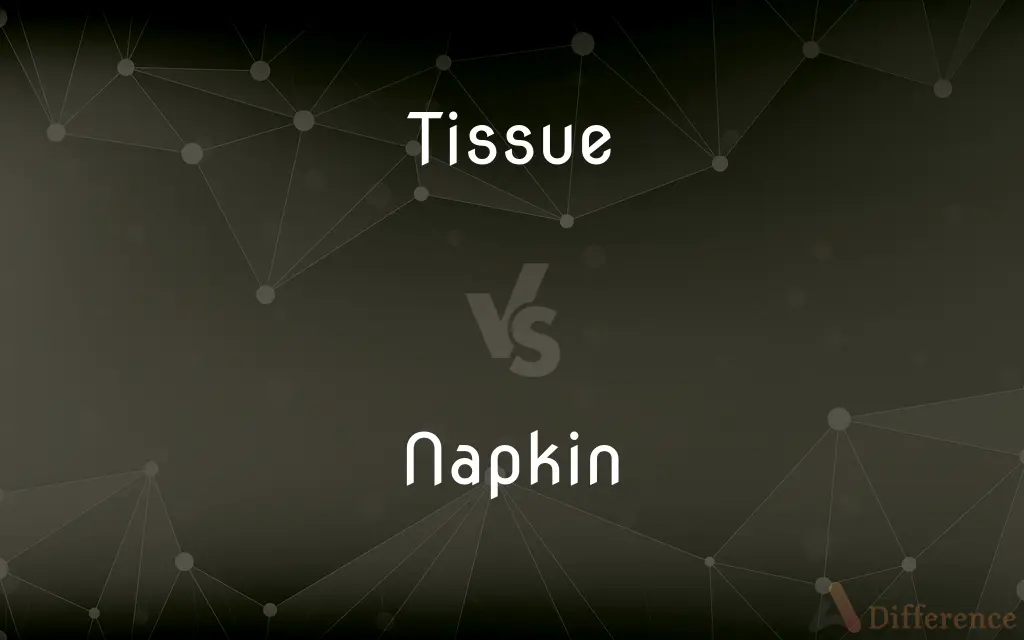Tissue vs. Napkin — What's the Difference?
By Maham Liaqat & Fiza Rafique — Updated on April 23, 2024
A tissue is a soft, absorbent paper used mainly for hygiene purposes like blowing one's nose or wiping tears, while a napkin is a piece of fabric or paper used during meals to wipe the mouth and hands or to protect clothing.

Difference Between Tissue and Napkin
Table of Contents
ADVERTISEMENT
Key Differences
Tissues are typically made from thin, soft paper designed for single-use personal hygiene. They are commonly used for nasal hygiene, especially during colds or allergies, and are gentle enough not to irritate the skin. Napkins, on the other hand, are used primarily in dining settings to clean the hands and face and to protect clothing from food spills. They can be made of fabric or paper, with fabric napkins being reusable and paper napkins being disposable.
The primary function of tissues is to manage bodily fluids, particularly from the nose and eyes, efficiently and sanitarily. Napkins serve a social function as well, often part of table settings in both casual and formal dining, reflecting etiquette and decorum.
Tissues are engineered to be gentle and soft, often infused with lotions or aloe to minimize irritation of sensitive facial skin. Fabric napkins, in contrast, are designed for durability and repeated use, frequently laundered after meals, and selected to complement dining room aesthetics or theme.
The disposability of tissues reflects their role in health and hygiene, as they are intended to prevent the spread of germs by being discarded after a single use. Paper napkins, while also disposable, balance cost-effectiveness with functionality in food service settings, whereas cloth napkins highlight sustainability and elegance.
In packaging and presentation, tissues are commonly found in boxes that dispense them one at a time, suitable for home or personal use. Napkins, whether fabric or paper, are often presented as part of a table setting, folded in decorative shapes or held by napkin rings for added aesthetic appeal.
ADVERTISEMENT
Comparison Chart
Material
Soft, thin paper
Fabric or paper
Primary Use
Personal hygiene (nasal, facial)
Dining cleanliness and etiquette
Disposability
Designed for single use
Paper: single use; Fabric: reusable
Features
Often lotion-infused
May be decorative, often larger
Presentation
Box dispensers
Folded on dining tables
Compare with Definitions
Tissue
Designed for single use.
After sneezing, it's best to throw the tissue away immediately.
Napkin
Fabric or paper for dining use.
He unfolded his napkin as the meal began.
Tissue
Often infused with soothing lotions.
His tissues are lotion-infused to prevent a sore nose.
Napkin
Reusable if made from fabric.
The cloth napkins were washed and ironed for the next dinner party.
Tissue
Soft, absorbent paper for hygiene.
She used a tissue to dab at her teary eyes.
Napkin
Can be decorative in settings.
The napkins were folded into swans for the wedding reception.
Tissue
Packaged for convenience.
The tissues come in a small pack that fits easily in a purse or pocket.
Napkin
Serves protective and decorative purposes.
She chose red napkins to match the tablecloth and protect guests' clothing from spills.
Tissue
Focus on sanitary handling.
Using a tissue helps prevent the spread of germs.
Napkin
Part of table etiquette.
Placing your napkin on your lap is basic table manners.
Tissue
A fine, very thin fabric, such as gauze.
Napkin
A napkin, serviette or face towelette is a square of cloth or paper tissue used at the table for wiping the mouth and fingers while eating. It is usually small and folded, sometimes in intricate designs and shapes.
Tissue
Tissue paper.
Napkin
A piece of cloth or absorbent paper used at table to protect the clothes or wipe the lips and fingers.
Tissue
A soft, absorbent piece of paper used as toilet paper, a handkerchief, or a towel.
Napkin
A cloth or towel.
Tissue
An interwoven or interrelated number of things; a web; a network
"The text is a tissue of mocking echoes" (Richard M. Kain).
Napkin
A sanitary napkin.
Tissue
(Biology) An aggregation of morphologically similar cells and associated intercellular matter acting together to perform one or more specific functions in an organism. There are four basic types of tissue in many animals
Muscle, nerve, epidermal, and connective.
Napkin
Chiefly British A diaper.
Tissue
Thin, woven, gauze-like fabric.
Napkin
A serviette; a (usually rectangular) piece of cloth or paper used at the table for wiping the mouth and hands for cleanliness while eating.
Tissue
A fine transparent silk material, used for veils, etc.; specifically, cloth interwoven with gold or silver threads, or embossed with figures.
Napkin
A nappy (UK), a diaper (American).
Tissue
A sheet of absorbent paper, especially one that is made to be used as tissue paper, toilet paper or a handkerchief.
Napkin
A small scarf worn on the head by Christian women (chiefly Roman Catholic and Eastern Orthodox) when entering a church, as a token of modesty.
Tissue
Absorbent paper as material.
Napkin
A little towel, made of cloth or paper, esp. one for wiping the fingers and mouth at table.
Tissue
(biology) A group of cells (along with their extracellular matrix if any) that are similar in origin and function together to do a specific job.
Napkin
A handkerchief.
Tissue
Web; texture; complicated fabrication; connected series.
A tissue of forgeries, or of lies
Napkin
To protect clothing; wipe mouth
Tissue
The scratch sheet or racing form.
Napkin
Garment consisting of a folded cloth drawn up between the legs and fastened at the waist; worn by infants to catch excrement
Tissue
To form tissue of; to interweave.
Tissue
A woven fabric.
Tissue
A fine transparent silk stuff, used for veils, etc.; specifically, cloth interwoven with gold or silver threads, or embossed with figures.
A robe of tissue, stiff with golden wire.
In their glittering tissues bear emblazedHoly memorials.
Tissue
One of the elementary materials or fibres, having a uniform structure and a specialized function, of which ordinary animals and plants are composed; a texture; as, epithelial tissue; connective tissue.
Tissue
Fig.: Web; texture; complicated fabrication; connected series; as, a tissue of forgeries, or of falsehood.
Unwilling to leave the dry bones of Agnosticism wholly unclothed with any living tissue of religious emotion.
Tissue
To form tissue of; to interweave.
Covered with cloth of gold tissued upon blue.
Tissue
A part of an organism consisting of an aggregate of cells having a similar structure and function
Tissue
A soft thin (usually translucent) paper
Tissue
Create a piece of cloth by interlacing strands of fabric, such as wool or cotton;
Tissue textiles
Common Curiosities
What is the main purpose of a tissue?
The main purpose of a tissue is for personal hygiene, particularly for the nose and face, to maintain cleanliness and health.
What makes tissues different from toilet paper?
Tissues are softer and often lotion-infused to prevent irritation during use on the face, while toilet paper is designed for bathroom hygiene and might be rougher.
Can napkins be used in place of tissues?
While napkins can occasionally be used in place of tissues, they are generally coarser and less suitable for sensitive facial areas.
Why might someone choose fabric napkins over paper?
Fabric napkins are chosen for their reusability and elegance, often used in formal dining settings to enhance the table's aesthetic.
Are there different types of tissues for specific uses?
Yes, there are various types of tissues designed for specific uses, such as facial tissues which are soft for sensitive skin, and those enhanced with antiviral coatings to help reduce the spread of germs.
What is the environmental impact of using tissues?
The environmental impact of using tissues includes deforestation and the energy consumption associated with their production and disposal. Biodegradable options and those made from recycled materials are available to help mitigate these impacts.
How are paper napkins made environmentally friendly?
Paper napkins can be made from recycled materials or managed forests to reduce environmental impact, though their disposability still raises ecological concerns.
How should napkins be placed during a formal dining setting?
In a formal dining setting, napkins should be placed on the lap immediately upon sitting down. They can be elegantly folded and placed either on the plate or to the left of the fork when the table is set.
Is it more cost-effective to use fabric napkins over paper napkins?
Over the long term, fabric napkins can be more cost-effective than paper napkins due to their reusability. Despite the initial investment and laundry costs, they do not need to be repurchased frequently, which is often the case with paper napkins.
Can decorative folding enhance the function of napkins in any way?
Decorative folding of napkins primarily serves an aesthetic purpose in setting a dining table, but it can also imply the formality of an occasion and potentially enhance the guests' dining experience by showing attention to detail.
Share Your Discovery

Previous Comparison
Pile vs. Dolly
Next Comparison
Boba vs. SagoAuthor Spotlight
Written by
Maham LiaqatCo-written by
Fiza RafiqueFiza Rafique is a skilled content writer at AskDifference.com, where she meticulously refines and enhances written pieces. Drawing from her vast editorial expertise, Fiza ensures clarity, accuracy, and precision in every article. Passionate about language, she continually seeks to elevate the quality of content for readers worldwide.














































